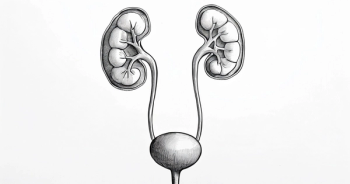
Case-Based Roundtable Meetings Spotlight
- Case-Based Roundtable Meetings Spotlight: March 2, 2023
- Volume 6
- Issue 4
- Pages: 43
Roundtable Roundup: Frontline Renal Cell Carcinoma Therapy
In separate live, virtual events, Ulka N. Vaishampayan, MBBS, and David A. Braun, MD, PhD, discussed options for a patient with favorable-risk clear cell renal cell carcinoma.
CASE SUMMARY
- A 61-year-old man, married, with 2 grown children and 5 grandchildren who live nearby and an active lifestyle (walks daily, golfs regularly)
- History of low-volume, indolent metastatic clear cell renal cell carcinoma (ccRCC)
- Underwent left nephrectomy and adrenalectomy
- Observation based on low-volume, indolent behavior of disease and patient preference
- Three years after nephrectomy: continued indolent growth on scans, increased total tumor burden, new paratracheal lymph node (2 × 1.5 cm), and more than 10 pulmonary nodules based on CT scan
- Metastatic ccRCC confirmed by lung biopsy
- Laboratory results within normal limits
- ECOG performance status: 0
VAISHAMPAYAN: The liver metastases are not part of the IMDC [International mRCC Database Consortium] risk criteria, but when we see liver metastases, it changes our thinking about the patient. The National Comprehensive Cancer Network guidelines [do not always] help because [they] still include 3 regimens as preferred, which [are] axitinib [Inlyta]/pembrolizumab [Keytruda], cabozantinib [Cabometyx]/nivolumab [Opdivo], and lenvatinib [Lenvima]/pembrolizumab.1 Ipilimumab [Yervoy]/ nivolumab is only approved [by the] FDA in [patients with] intermediate- or poor-risk [disease]. So [it isn’t approved] in favorable-risk disease, which is what this patient has, although we did discuss that with liver metastases you would have concerns about considering this as favorable-risk disease.
But these are the 3 regimens, and single-agent cabozantinib and multiple tyrosine kinase inhibitors are options. Ipilimumab/nivolumab is [the] other recommended regimen because it was looked at in patients with favorable-risk disease. But it did not show progression-free survival and overall survival [OS] benefit, so because of that, it is not approved [by the] FDA.
BRAUN: There’s always a caution with cross-trial comparisons. [The CheckMate 214 (NCT02231749), KEYNOTE-426 (NCT02853331), CheckMate 9ER (NCT03141177), and CLEAR (NCT02811861) trials] have different patient populations, different percentages of patients [with] favorable-risk [disease]…and different durations of follow-up.2-5
So when we look at median OS and response rate, it’s important to take [these] with a grain of salt. One of the things that I look at is the OS HR [because] they at least had a uniform comparator with sunitinib. We see that for OS, the HR is roughly equivalent across these different trials. There are a lot of similarities, probably more similarities than differences. Response rates are high across the board. [Those are] highest in the lenvatinib/pembrolizumab combination. That’s where we see the highest complete response rates, but it's a different patient population, more patients with favorable-risk disease.5 Then we see different primary progressive disease rates.
REFERENCES
1. NCCN. Clinical Practice Guidelines in Oncology. Kidney cancer, version 4.2023. Accessed February 14, 2023. https://bit.ly/3RbPK6X
2. Motzer RJ, Tannir NM, McDermott DF, et al. 661P conditional survival and 5-year follow-up in CheckMate 214: first-line nivolumab + ipilimumab (N+I) versus sunitinib (S) in advanced renal cell carcinoma (aRCC). Ann Oncol. 2021;32(suppl 5):S685-S687. doi:10.1016/j.annonc.2021.08.057
3. Rini BI, Plimack ER, Stus V, et al. Pembrolizumab (pembro) plus axitinib (axi) versus sunitinib as first-line therapy for advanced clear cell renal cell carcinoma (ccRCC): results from 42-month follow-up of KEYNOTE-426. J Clin Oncol. 2021;39(suppl 15):4500. doi:10.1200/JCO.2021.39.15_suppl.4500
4. Choueiri TK, Powles T, Burotto M, et al; CheckMate 9ER Investigators. Nivolumab plus cabozantinib versus sunitinib for advanced renal-cell carcinoma. N Engl J Med. 2021;384(9):829-841. doi:10.1056/NEJMoa2026982
5. Motzer R, Alekseev B, Rha SY, et al; CLEAR Trial Investigators. Lenvatinib plus pembrolizumab or everolimus for advanced renal cell carcinoma. N Engl J Med. 2021;384(14):1289-1300. doi:10.1056/NEJMoa2035716






































